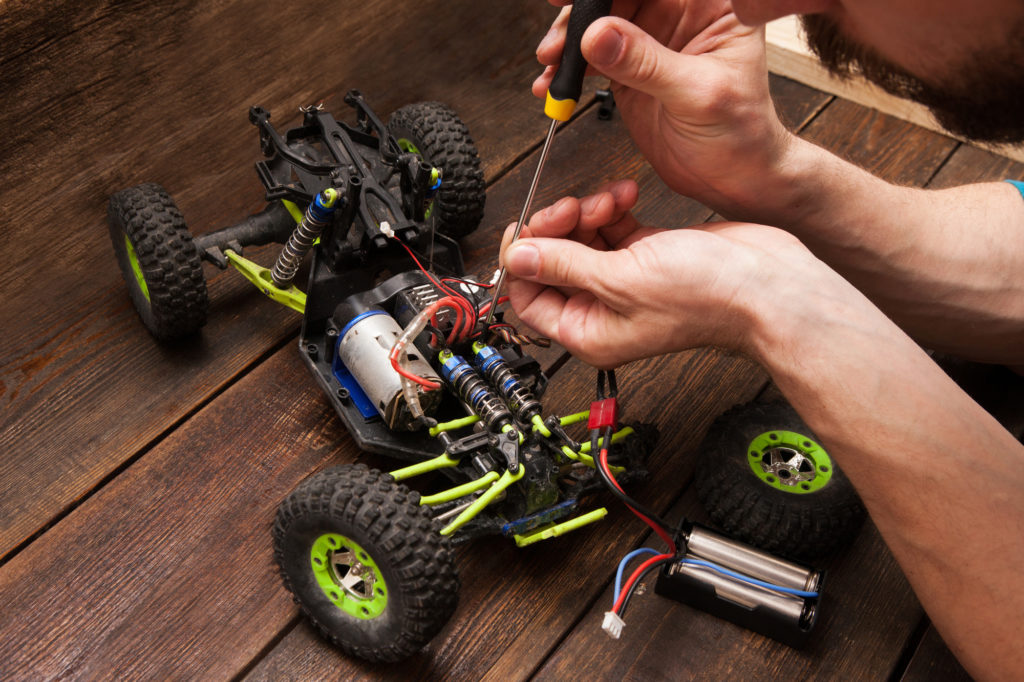
Have you ever had a fascination with remote-controlled cars? Have you ever played with one as a kid and thought to yourself it would be amazing to make your RC car?
Did you know they rank as one of the top 10 grossing toys in the toy market? It’s likely that in every neighborhood, a kid back in the day had the same thought as you did.
With today’s toy market and new technology, you can make that dream a reality.
It’s easier to build your own RC car than you’d think. Let us show you how to get it done.
Grab your tool belt and let’s get started on making your customizable RC car. Let’s begin with getting the right parts:
Parts
When you’re going to build your own RC car from scratch, the first thing you’ll do is decide what you’ll want to use for parts. You can buy genuine RC parts from a toy store or online from different marketing sites like this website, or you can go around your own house and salvage parts from there.
Here’s a list of the essentials when building an RC car.
Body
For the body, you’d want to consider something hard, light, and durable. Your RC car is going to take a lot of strain from carrying the essentials on it, as well as banging on any obstacle it might encounter.
Consider selecting something like PVC pipes and connectors for the freedom they provide in modifying the car’s frame. Their hollow interior also provides you with more room to work with and makes the whole RC car light.
Wheels
When you build an RC car, your wheels can’t be anything round you find at your house. It has to have excellent traction so it won’t slip off when you hit the brakes. With this in mind, finding actual substitutes for wheels will be a hard task, so consider ordering them instead.
Batteries
A simple 9v battery should suffice for basic homemade RC cars. These should give you about 24 hours of fun.
However, if you want your RC car to drive longer and give a better performance, using lithium-polymer batteries can also be an option, assuming you take care when using them and know how to maintain them.
Motor
The traditional motor for an RC car is a DC geared motor. While small, they usually provide at least 200 RPM of power for your car. You will need at least a pair of these for your wheels on the back.
If you want to get creative, there are also motors similar to a DC geared motor that you can find inside hand drills.
Controller
It’s not a remote-controlled car without a controller. You can salvage one of your old RC car remotes, and it will still work with a few modifications to its transmitter. Or, you can use any wireless controller, like that of a PlayStation 3.
Receiver
You can find radio receivers online. Remember that a receiver should have its own power source. A 12v battery should be ideal for them.
Steering Servo
Something you’ll need to control the steering of your RC car. You can either buy one online or salvage one from an old RC car. And with your country leading in imports of toys and games, it should not be that hard to find one.
Wires
You’re going to need a lot of wires to connect your motors and your receivers to your batteries.
Now that you have all the parts you need, it’s time for you to grab your tools and your soldering iron. It’s time for you to build an RC car!
Build Your Own RC Car
First off, you’ll want to think of a frame for your RC car. Think of the general design, how you’d want it to look like, and measure your PVC pipes and connectors and cut them up in those ways. Always remember to measure twice and cut once.
Once you’ve mapped out what your RC car will look like, place something sturdy but mold-able like cardboard or a peg board over the base to support the insides. Once you’ve done that, you have now completed your chassis.
Mount Your Wheels
At the back of your RC car, secure your two motors and mount your wheels on to them. At the front, place two wheels connected by steering rods.
Connect the steering rods you have linked to your wheels to a servo connector to be able to command them with your controller.
Wiring Your RC Car
After you mount your receiver and its battery pack unto your chassis, take the wires and, using your soldering iron, solder the battery pack unto the remote receiver’s power input.
Then, take the wires from the remote receiver again, and this time solder the wires unto the motors. Do the same thing for your servo connector.
Doing these will make sure that you have control over the thrust of the RC car and its steering.
Bind Your Remote Control to Your Receiver
More modern remote receiver designs come with a binding cable to help it bind to almost any RC car’s remote control. To do this, you must first plug the binding cable to the port on your receiver that says “bind,” turn your car on, and you’ll notice that there’s a blinking red light from the receiver.
The blinking red light indicates that the receiver is not connected to the controller.
To connect your controller, take the key that comes along with the binding cable. Press it against the port that’s found in your controller, usually in the middle of the analog sticks. Turn your controller on and hold the key in the port for around 2 seconds.
Now you should notice that the light on the receiver is steady, this means that the receiver is now bound to your transmitter.
This part is tricky, and most are likely to fail on their first try, but don’t let failure get you. Keep trying, and you’ll get it right.
Protect Your RC Car
Now that you’ve done all that you needed to get your car running, all that’s left to do is to house its insides. You don’t want your wirings to be out and about when you start your car.
Make sure that you secure your wirings first before covering your RC car with something light. Securing it with the heavy material will put stress on the wheels.
Build and Customize Your Own RC Car Now
Making your RC car has never been easier as long as you follow these steps. With this guide, you can now build your own RC car.
But don’t stop there!
We have more exciting guides and posts for you to discover, like this one which discusses what you need to build the optimal gaming PC.

